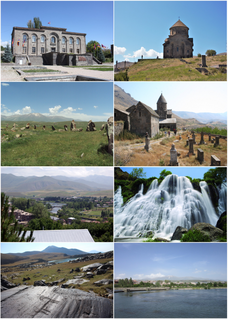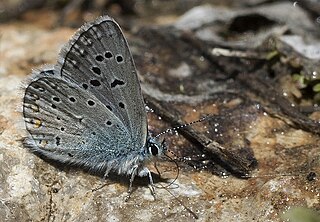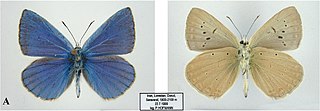
The chalkhill blue is a butterfly in the family Lycaenidae. It is a small butterfly that can be found throughout the Palearctic realm, where it occurs primarily in grasslands rich in chalk. Males have a pale blue colour, while females are dark brown. Both have chequered fringes around their wings.

Meghri is a town and the center of the urban community of Meghri, in Syunik Province in southern Armenia, near the border with Iran. As of the 2011 census, the population of the town was 4,580. According to the 2020 official estimate, Meghri's population is around 4,500. Meghri is located 376 km south of the capital Yerevan and 73 km south of the provincial capital Kapan.

Sisian is a town and the centre of the urban community of Sisian, in the Syunik Province in southern Armenia. It is located on Vorotan River, 6 km south of the Yerevan-Meghri highway, at a road distance of 217 km southeast of the capital Yerevan, and 115 km north of the provincial centre Kapan.

Sevan National Park, is one of the four protected national parks of Armenia, founded in 1978 to protect Lake Sevan and the surrounding areas. It is under the jurisdiction of the Ministry of Environment and includes a research center, which monitors the ecosystems, and undertakes various conservation measures. Licensed fishing on the lake is also regulated.

Polyommatus eros, the Eros blue or common meadow blue, is a species of blue butterfly found in the Palearctic.

Lichk is a village in the Meghri Municipality of the Syunik Province in Armenia.

Polyommatus daphnis, the Meleager's blue, is a butterfly of the family Lycaenidae.

Polyommatus myrrha is a species of butterfly in the family Lycaenidae. It was first described as Lycaena myrrha by Gottlieb August Wilhelm Herrich-Schäffer in 1851 in the six volume Systematische Bearbeitung der Schmetterlinge von Europa. This rare species has been found in Anatolia area of Turkey. and in the Zangezur Mountains, which is inhabited by subspecies P. m. cinyraeaNekrutenko & Effendi, 1979.

Kajaran is a town and the centre of the Kajaran Municipality in Syunik Province in southern Armenia. It is located 356 km south of the capital Yerevan, 25 km west of the provincial centre Kapan, and 50 km north of the Armenia-Iran border.

Khosrov Forest State Reserve, is a nature reserve in Ararat Province of Armenia. The reserve is one of the oldest protected areas in the world having a history of about 1700 years. It was founded in the 4th century (334–338) by the order of Khosrov Kotak, King of Armenia who gave it his name. It was founded to improve the natural climatic conditions of adjacent territories of Artashat – the capital city of Armenia of the given period and the newly established city of Dvin to ensure conservation and enrichment of flora and fauna species; serve as a ground for royal hunting, military exercises and entertainments.
Polyommatus aserbeidschanus is a butterfly in the family Lycaenidae. It was described by Walter Forster in 1956. It is found in the Caucasus, Armenia and Turkey.

Polyommatus (Agrodiaetus) violetae, the Andalusian anomalous blue, is a species of butterfly in the family Lycaenidae. It is found in the south and south-east of Spain. Adults are on wing from July to August.
Polyommatus zarathustra, the Zarathustra blue, is a butterfly of the family Lycaenidae. It was described by Eckweiler in 1997. It is endemic of southern slope of the Meghri Mountains in Armenia and nearby Arasbaran Mountains in northern Iran. Armenia is inhabited by subspecies P. z. neglecta. It inhabits forests alternated with dry steppe-like areas at elevations of 1400–1900 m above sea level. The species is included in the Red Book of Animals of the Republic of Armenia as endangered EN B1a+B2a.

Lysandra corydonius, the false chalkhill blue, is a butterfly of the family Lycaenidae. The species is distributed in south-eastern Europe, Caucasus, Transcaucasia, north-eastern Turkey, and north-western Iran. L.corydonius is very similar to Lysandra coridon but a slight violet sheen is present, especially in the outer area of the wings. .It inhabits a wide variety of grasslands and woodlands. In Armenia it occurs from 1200 to 2000 m above sea level. The known larval host plants of the species in Turkey is Hippocrepis comosa, in the Caucasus - Coronilla varia. The species has not been assessed for the IUCN Red List. In Armenia from 2003 to 2013 its population increased.

Polyommatus karindus is a butterfly of the family Lycaenidae. It was described by Norman Denbigh Riley in 1921. It is only known from the Iranian Zagros Mountains. The habitat consists of dry slopes, gorges and plateaus with xerophyte or steppe vegetation, sometimes wooded areas from 1,800 up to 2,800 meters.

Arevik National Park, is one of the four protected national parks of Armenia. Occupying an area of 344 km2, it is located in the southern Syunik Province of Armenia.

Tomares romanovi, or Romanoff's hairstreak, is a butterfly of the family Lycaenidae. It is found in Armenia, Azerbaijan, Georgia, eastern Turkey, northern Iran, and Kopet Dagh mountains.

Ali Botush, also spelled Alibotoush, is a nature reserve in the small mountain range of Slavyanka, located on the border between Bulgaria and Greece. The reserve occupies the northern section of the mountain which lies within the territory of Bulgaria and takes its name from the old name of Slavyanka. It is situated in the municipalities of Sandanski and Hadzhidimovo, Blagoevgrad Province. It was declared in 1951 to protect the largest forests of the endemic Bosnian pine in the Balkan Peninsula. Its territory was further expanded several times and spans an area of 1638 ha or 16,38 km2. It was declared a UNESCO Biosphere Reserve in 1977.
Polyommatus (Agrodiaetus) ninae, or Nina's blue, is a butterfly of the family Lycaenidae described by Walter Forster in 1956. It is found in Armenia, Azerbaijan, Georgia, eastern Turkey, and northern Iran (Kurdistan).















